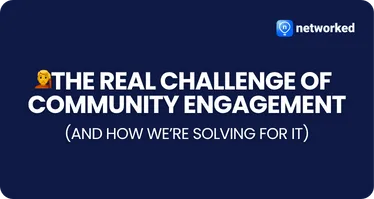Member relationships form the backbone of your community. It’s a fact. They drive engagement, retention, and overall satisfaction. When members feel valued and connected, they are more likely to participate actively, renew their memberships, and spread positive word-of-mouth about your organization. In essence, strong member relationships are the foundation of a thriving membership organization.

Brief Overview of Key Strategies
To enhance member relationships, it’s crucial to focus on several key strategies. These include making a great first impression, actively listening and engaging with members, building trust and credibility, personalizing interactions, maintaining a service-oriented mindset, and continuously seeking feedback to improve. Each of these strategies plays a vital role in creating and nurturing meaningful connections with your members, ensuring their long-term loyalty and satisfaction.
The First Impression Matters
You never get a second chance to make a first impression. This saying holds especially true for membership organizations, where the initial interactions members have with your organization can significantly influence their future engagement. When new members join, their first few experiences shape their perception of your organization’s values and commitment to their needs. Questions like “Did staff respond promptly when I reached out?” or “Were staff knowledgeable and helpful in answering my questions?” can set the tone for their ongoing relationship with your organization.
Ways to Make a Positive First Impression
Creating a positive first impression involves several key actions. First, ensure that your staff is well-trained and equipped to handle inquiries promptly and efficiently. A warm, welcoming demeanor combined with a willingness to assist can make a significant difference. Additionally, provide clear, accessible information about the benefits of membership and how members can take advantage of them. Personalized welcome messages, orientation sessions, and follow-up communications can also help new members feel valued and engaged right from the start.
Prompt Responses
Responding to member inquiries promptly is a fundamental aspect of creating a positive first impression. When members reach out with questions or concerns, they expect quick and efficient responses. Timely replies demonstrate that your organization values their time and is dedicated to addressing their needs. This immediate attention helps build trust and sets the stage for a strong, lasting relationship.
Examples of Effective Communication
Effective communication goes beyond just responding quickly. It’s about providing clear, concise, and helpful information. For instance, if a member inquires about an upcoming event, an effective response would not only include the event details but also provide additional resources, such as a link to the registration page or a schedule of future events. Personalized messages, such as addressing the member by name and referencing their specific inquiry, can also enhance the quality of the communication. Additionally, using a friendly and approachable tone helps create a welcoming atmosphere.
Knowledgeable Staff
Training Staff to Be Helpful and Informed
The knowledge and competence of your staff play a crucial role in shaping members’ perceptions of your organization. Investing in comprehensive training programs ensures that staff members are well-versed in all aspects of the organization, from membership benefits to event details and beyond. Regular training sessions can keep staff updated on the latest developments and best practices, enabling them to provide accurate and helpful information to members.
The Role of Staff in Shaping Perceptions
Staff interactions are often the first point of contact for members, making them pivotal in shaping the overall perception of your organization. When staff members are knowledgeable and able to address inquiries effectively, it reassures members that they are in good hands. Furthermore, staff who go above and beyond to assist members can significantly enhance member satisfaction and loyalty. For example, if a member has a complex question, a staff member who takes the time to thoroughly explain and provide additional resources can leave a lasting positive impression.
Active Listening and Engagement
Active listening is the cornerstone of effective member engagement. By truly listening to your members, you show that you value their input and are committed to meeting their needs. This builds trust and fosters a deeper connection between members and the organization. When members feel heard, they are more likely to stay engaged and contribute positively to the community.
Techniques for Active Listening
Active listening involves more than just hearing words; it requires understanding the underlying messages and emotions. Techniques for active listening include maintaining eye contact, nodding in agreement, and providing verbal affirmations like “I understand” or “That makes sense.” Reflecting back what the member has said to confirm understanding and asking open-ended questions to encourage further discussion are also effective strategies. These techniques help ensure that members feel genuinely heard and understood.
Methods to Gather Member Feedback
To effectively understand member needs, it’s essential to gather feedback regularly. Surveys, polls, and feedback forms are valuable tools for collecting insights. Additionally, hosting focus groups or town hall meetings allows for more in-depth discussions. Social media platforms and online forums can also be useful for gauging member sentiment and identifying common concerns.
Using Feedback to Improve Services
Once feedback is collected, it’s crucial to act on it. Analyze the data to identify patterns and areas for improvement. Implement changes based on member suggestions and communicate these changes to show that their input is valued and making a difference. For example, if members express a desire for more networking opportunities, consider organizing additional events or online networking sessions. This continuous loop of feedback and improvement strengthens member relationships and enhances the overall member experience.
Personalized Communication
Benefits of 1:1 Communication
1:1 communication can significantly enhance member relationships by making interactions more personal and meaningful. Personal phone calls, emails, or even face-to-face meetings can create a stronger bond between members and the organization. These personalized interactions show members that they are valued as individuals, not just as part of a larger group. This personal touch can lead to increased member satisfaction and loyalty.
Balancing Mass Communication with Personal Touch
While mass communication is necessary for disseminating information efficiently, it’s important to balance it with personalized messages. Automated emails and newsletters can be tailored with personalized elements, such as using the member’s name or referencing their specific interests and activities. Segmenting your audience based on their preferences and engagement history allows you to send more relevant and personalized content. Combining mass communication with personalized interactions ensures that all members feel connected and valued.
Building Trust and Credibility
Establishing Trust with Members
Trust is a fundamental component of any successful relationship, including those between membership organizations and their members. Establishing trust involves being transparent, consistent, and reliable. It’s important to communicate openly about the organization’s goals, values, and operations. When members trust that the organization has their best interests at heart, they are more likely to stay engaged and loyal.
Consistency in Communication and Actions
Consistency is key to building and maintaining trust. This means ensuring that all communications, whether from staff, emails, or social media, align with the organization’s values and messages. It also means following through on promises and commitments. For example, if the organization promises to provide certain resources or support, it must deliver on these promises consistently. Consistent actions reinforce the organization’s reliability and commitment to its members, further strengthening trust and credibility.
Transparency and Honesty
Transparency is essential in fostering trust within a membership organization. Members need to feel confident that they have access to accurate and complete information about the organization’s operations, decisions, and financial status. Transparent practices include clear communication about organizational goals, decision-making processes, and financial reports. By being open and honest, you demonstrate respect for your members and invite their trust and engagement.
How Honesty Builds Long-Term Trust
Honesty, especially in difficult situations, is crucial for building long-term trust. When mistakes happen or challenges arise, being upfront with your members can reinforce their faith in your integrity. Addressing issues directly, providing explanations, and outlining steps for resolution show that the organization is accountable and committed to improvement. This level of honesty not only resolves immediate concerns but also strengthens the bond of trust over time.
Delivering on Promises
Ensuring Commitments Are Met
Delivering on promises is a key aspect of maintaining trust and credibility with your members. When your organization commits to providing certain services, benefits, or events, it is essential to follow through. Consistently meeting or exceeding expectations demonstrates reliability and builds confidence in the organization’s leadership and operations. Establishing clear timelines and regularly updating members on the progress of commitments can help manage expectations and enhance trust.
Impact of Reliability on Member Trust
Reliability is the foundation of a trustworthy relationship. When members can depend on your organization to fulfill its promises, their trust and loyalty increase. This reliability encourages ongoing engagement and can lead to positive word-of-mouth recommendations. In contrast, failing to meet commitments can damage the organization’s reputation and erode member trust, making it crucial to prioritize reliability in all member interactions.
Personalization and Attention to Detail
Personalizing Member Interactions
Personalized interactions show members that they are valued as individuals, not just as part of a larger group. This can be achieved by addressing members by their names, acknowledging their past participation in events, or referring to their specific interests. Personalization fosters a sense of belonging and makes members feel more connected to the organization. It also enhances their overall experience and satisfaction.
Keeping Track of Member Preferences
To effectively personalize interactions, it’s important to keep track of member preferences and histories. This includes noting their preferred communication methods, interests, and any previous feedback they’ve provided. By maintaining detailed member profiles, you can tailor your communications and offerings to better meet their needs. This attention to detail shows members that you care about their individual experiences and are committed to providing them with relevant and meaningful interactions.
Tailored Experiences
Creating Unique Experiences for Members
Creating unique and tailored experiences can significantly enhance member satisfaction and loyalty. This might involve offering exclusive events, personalized content, or specialized programs that align with their interests. For example, if you know certain members are interested in professional development, you can invite them to relevant workshops or webinars. Tailored experiences make members feel special and appreciated, increasing their overall engagement with the organization.
Using Data to Personalize Interactions
Leveraging data is crucial for personalizing member interactions effectively. Collecting and analyzing data on member behavior, preferences, and feedback allows you to customize your offerings and communications. For instance, using a CRM system to track member activities and interactions can help you identify trends and preferences. This data-driven approach ensures that your personalization efforts are accurate and impactful, enhancing the member experience.
Remembering Important Details
Keeping track of important details about your members, such as their interests, birthdays, or past interactions, can make a significant difference in personalizing their experience. Noting these details shows members that you pay attention and value their individual preferences. This can be done through a well-maintained database or CRM system where you can log and retrieve member information easily.
Tools to Help Track Member Information
Several tools can assist in tracking member information effectively. Customer Relationship Management (CRM) systems, such as Salesforce or HubSpot, allow organizations to maintain detailed profiles of each member, including their preferences, interaction history, and feedback. These tools help automate the process of tracking and retrieving member information, ensuring that no detail is overlooked. Using such tools enables your organization to provide a more personalized and attentive member experience.
Service-Oriented Mindset
Adopting a service-oriented mindset means prioritizing the needs and satisfaction of your members in all interactions. This approach emphasizes going beyond the basic requirements to provide exceptional service and support. By viewing every interaction as an opportunity to serve and assist members, your organization can foster a culture of care and attentiveness that resonates with members and encourages their loyalty.
How a Service-First Approach Benefits Members
A service-first approach ensures that members feel valued and supported, which can lead to increased satisfaction and engagement. When members experience consistently excellent service, they are more likely to remain loyal and advocate for your organization. This approach also helps in addressing and resolving any issues promptly, further reinforcing the member’s trust and satisfaction with the organization.
Going the Extra Mile
Examples of Exceptional Member Service
Examples of going the extra mile include personalized follow-up calls after events to gather feedback, offering tailored solutions to specific member problems, and providing additional resources that members might find useful. For instance, if a member has difficulty accessing a service, offering a personalized tutorial or a dedicated support session can make a significant difference. These extra efforts show members that you are committed to their success and satisfaction.
Long-Term Benefits of Extra Effort
The long-term benefits of going the extra mile include increased member loyalty, positive word-of-mouth, and a stronger reputation for your organization. Members who feel exceptionally cared for are more likely to renew their memberships and recommend your organization to others. This positive cycle of satisfaction and recommendation can lead to sustained growth and success for your organization.
Training for Service Excellence
Importance of Ongoing Staff Training
Ongoing staff training is crucial for maintaining a high standard of service excellence. Regular training sessions help staff stay updated on best practices, new tools, and effective communication strategies. This ensures that they are well-equipped to handle member inquiries and provide exceptional service consistently. Continuous learning and development opportunities also keep staff motivated and engaged, which translates to better service for members.
Methods for Training Staff in Service Excellence
Effective methods for training staff in service excellence include workshops, role-playing scenarios, and online training modules. Providing real-life examples and case studies can help staff understand the importance of excellent service and how to achieve it. Encouraging staff to share their own experiences and solutions can also foster a collaborative learning environment. Additionally, regular feedback and performance reviews can help identify areas for improvement and tailor training programs accordingly.
By implementing these strategies, your organization can enhance member relationships, foster loyalty, and create a vibrant, engaged community.
Conclusion
Strong member relationships are vital for the success of membership organizations. By focusing on making a positive first impression, actively listening and engaging with members, building trust and credibility, personalizing interactions, maintaining a service-oriented mindset, and continuously seeking feedback to improve, organizations can create meaningful connections with their members. These strategies not only enhance member satisfaction and loyalty but also contribute to the overall growth and success of the organization.




